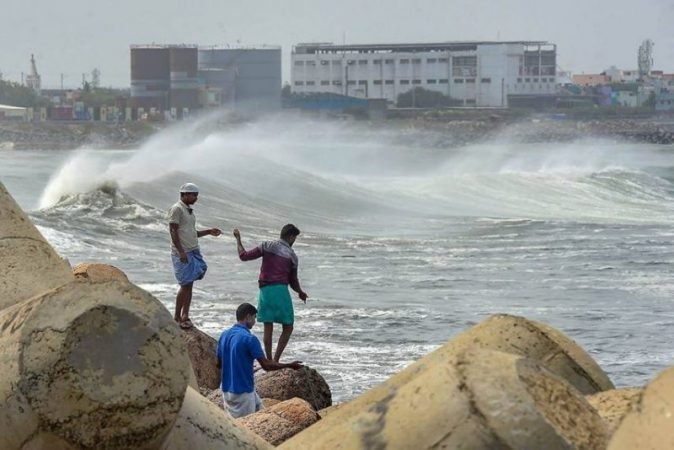Is India Ready? Coastal Cities and the Threat of Climate Change

In June this year, India’s financial capital Mumbai was in news not because of the alarming rise in corona cases, but due to the occurrence of a rare weather event in the form of cyclone Nisarga, which made landfall at Mumbai on 2nd June. Even as cyclones are not unusual for Indian Subcontinent, the Arabian Sea is known for its relative calmness as compared to the Bay of Bengal. In fact, it was the first severe cyclone to hit Mumbai in more than sixty years.
It could have been catastrophic especially with the rising cases of COVID-19 and the inability of health infrastructure to handle these disasters together. However, Mumbai was fortunate this time as the cyclone weakened before making the landfall. The problem of climate change has become an important discussion in academic, fiction and nonfiction literature but the government initiatives and policies do not reflect these concerns. Cyclone Nisarga serves as a warning to Indian cities which are least prepared to handle the repercussions of even subtle manifestations of climatic change.
Amitav Ghosh and his Warning to Mumbai
Amitav Ghosh, an acclaimed Indian writer, in his 2016 book The Great Derangement: Climate Change and the Unthinkable presciently warns about the threat to Mumbai due to climate change. Citing various studies and experts, Ghosh shows how cyclonic activity is set to intensify in Arabian Sea due to climate change; and in that respect it might surpass Bay of Bengal by the end of this century. Indian Meteorological Department’s (IMD) report that came out last year corroborates this by pointing out that in 2019 Arabian Sea generated the most number of cyclones since the previous record of 1902. One of the factors responsible for this is the warming up of Arabian Sea.
Ghosh traces the history of Mumbai’s development out of a low-lying estuarine zone, and by citing 2005 and 2015 floods, argues how Mumbai is unprepared to tackle even small cyclones and storm surges; the damage would be catastrophic if a category 4 or 5 cyclone were to hit Mumbai. The threat to Mumbai is significant and alarming because of the presence of critical financial, industrial, military and strategic establishments there.
Ghosh also makes an interesting argument regarding how coastlines have developed in India’s coastal cities. He critiques the way closeness to the shoreline has been confused with economic prosperity and offers the contrasting case of local communities which, relying on traditional knowledge, do not live/settle near the seas even as their livelihoods depend on it. This brazen encroachment of the coastlines has made coastal cities even more vulnerable.

Chennai: Calamity Hotspot and Poor Planning
Chennai, situated near the southern tip of India on the East Coast, has been facing chronic water shortages for many years now. The situation became particularly troubling in 2019 when the city’s main water supply sources (lakes, reservoirs) dried up. That this shortage of water came just a few years after the devastating floods of 2015 is even more worrying. In addition, Cyclones emanating from Bay of Bengal have been a regular visitor to the city; and the recent one was Cyclone Vardah which made landfall at Chennai in 2016.
The planning and construction of mega structures in the city has also aggravated the situation. For example, the airport is constructed on the banks of Adyar river and there is always a rick of excessive rain flooding the runway, as happened in 2015. The Chennai Mofussil Bus Terminus (CMBT) at Koyambedu, one of the largest bus terminus in the world, is also situated in a flood prone area. Apart from the problematic planning, one other major concern is the concentration of urban poor in the disaster prone areas.
Other Coastal Cities: A Story No Different
Kolkata, one of India’s oldest port cities, like Mumbai, was the recipient of a cyclone. In May this year, Cyclone Amphan, which was many times more powerful and destructive than Cyclone Nisarga, made landfall in Eastern parts of India as well as Bangladesh. West Bengal and Odisha were particularly hit. Incidentally, it also happened to be the first super cyclone to form in the Bay of Bengal since the 1999 Odisha Cyclone.
As regards to city planning and infrastructure, Kolkata fares no better than Chennai. In fact, the story of Mumbai, Chennai and Kolkata is the story of every Indian coastal city, whether facing the Arabian Sea or the Bay of Bengal. And, these coastal states are the most vulnerable in India due to climate change. Sustainable cities are the need of the hour; cities which can breathe, cities which can provide equitable housing, resilient infrastructure. All these adaptation measures should go hand in hand with strong mitigation measures so as to soften the manifestations and effects of climate change. It’s time to pay heed to Amitav Ghosh’s warnings.

Moving Beyond Anthropocentrism
It also needs to be seen how much change is possible as long as anthropocentrism — the view that humans are at the centre of the universe and that humans have dominance over nature — remains the prevailing and dominant belief. This is an urgent need to move towards an ecocentric philosophy wherein the natural world around us assumes primacy. This shift will also entail an acknowledgement of the existence of the non-human agency, that is, of both non-human life forms and even things which appear lifeless. That an extremely small coronavirus could disrupt and change our lives this much amply demonstrates the former; and that a natural disaster like volcanic eruption could make a populated area uninhabitable amply demonstrates the latter.
It is only when we embrace ecocentrism, that meaningful change would be possible, whether relating to building sustaining cities or addressing the biggest threat of the 21st century, Climate Change.


















